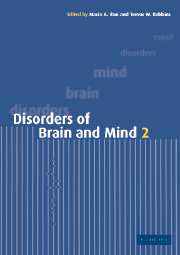Book contents
- Frontmatter
- Contents
- List of contributors
- Preface
- Part I Genes and behaviour
- Part II Brain development
- Part III New ways of imaging the brain
- Part VI Imaging the normal and abnormal mind
- 7 Functional neuro-imaging and models of normal brain function
- 8 Functional magnetic resonance imaging in psychiatry: where are we now and where are we going?
- 9 Positron emission tomography (PET) neurochemistry: where are we now and where are we going?
- Part V Consciousness and will
- Part IV Recent advances in dementia
- Part VII Affective illness
- Part VIII Aggression
- Part IX Drug use and abuse
- Index
- Plate section
- References
7 - Functional neuro-imaging and models of normal brain function
from Part VI - Imaging the normal and abnormal mind
Published online by Cambridge University Press: 19 January 2010
- Frontmatter
- Contents
- List of contributors
- Preface
- Part I Genes and behaviour
- Part II Brain development
- Part III New ways of imaging the brain
- Part VI Imaging the normal and abnormal mind
- 7 Functional neuro-imaging and models of normal brain function
- 8 Functional magnetic resonance imaging in psychiatry: where are we now and where are we going?
- 9 Positron emission tomography (PET) neurochemistry: where are we now and where are we going?
- Part V Consciousness and will
- Part IV Recent advances in dementia
- Part VII Affective illness
- Part VIII Aggression
- Part IX Drug use and abuse
- Index
- Plate section
- References
Summary
Introduction
Functional neuro-imaging techniques provide an unparalleled window on the living human brain. Using neuro-imaging techniques it has, for the first time, become possible to address fundamental questions regarding the neurobiological underpinnings of core human psychological functions, such as memory, attention and emotion. The present chapter will illustrate basic principles of normal brain function by considering how the brain processes a particular class of object, namely the human face. This example will be used to illustrate two distinct, though complementary, modes of brain function involving functional specialization and functional integration respectively. Evidence for functional specialization, a fundamental principle of brain organization, will be illustrated by consideration of neuro-imaging studies which show that a circumscribed region of inferior temporal cortex, the fusiform cortex, is selectively responsive to presentation of faces relative to other classes of objects. By contrast, functional integration, the idea that during complex psychological functions there is coordination of activity among functionally specialized brain regions, will be illustrated by considering the influence of selective attention and emotional content on patterns of activation in functionally specialized regions that mediate face processing.
Functional specialization
Humans are remarkably adept at recognizing individuals by their faces, an ability that may rely on specialized neural circuits (Bruce and Young 1986). Findings from ‘prosopagnosic’ brain-damaged patients with deficient face processing (Damasio et al. 1982), as well as physiological data from nonhuman primates (Rolls 1992), have now been supplemented by functional imaging results.
Information
- Type
- Chapter
- Information
- Disorders of Brain and Mind , pp. 151 - 170Publisher: Cambridge University PressPrint publication year: 2003
